
Kanawha Falls – C. Hamsher – 2008

Kanawha Falls Post Office – C. Hamsher – 2008

Bus House on a Rock – C. Hamsher – 2008
A few shots from a weekend trip down the Midland Trail on Route 60 at Gauley Bridge.

Vintage Style for Modern Living

The Purple Moon is closed Labor Day weekend as the modern lady and I relax, refresh and do some shopping to re-stock.
We will resume regular hours on Tuesday, September 2.

Dinette Set – Daystrom Corporation – 1954
First of all, I want this kitchen.
The Daystrom Corporation produced some of the coolest dinette sets to come out of the 1950’s. The one shown is from an advertisement for the company from 1954 when this dinette set could be yours for $155. To put this in perspective, adjusted to 2008 dollars this set cost $1242.30 according to the online consumer price index calculator of the Federal Reserve Bank of Minneapolis. And this isn’t even one of their higher end models.
Daystrom produced their furnishings on both coasts with a factory in Olean, NY and a Pacific Division in Pasadena, CA. We’ve had a number of these dinette sets over the years, from a number of makers, and have found Daystrom’s design and quality to be superior. Pieces are generally marked with labels under the table and on the seat bottom of the chairs. Daystrom produced furniture into the early 1970’s.
Did I mention that I want this kitchen?

Heywood-Wakefield Advertisement – The American Home Magazine – August 1953
As I had written earlier this week, the pile of The American Home magazines I recently ran across has been a treasure trove of fabulous information, images and style. It is always so nice to see how the vintage items I cherish now were originally presented, utilized, marketed and displayed.
The Heywood-Wakefield ad shown here includes pieces which are part of our collection. The china cabinet, buffet and dining chairs (with the drop leaf whalebone table not shown) all sit in my dining room. This exceptionally styled and crafted furniture is as stylish today as it was 55 years ago.
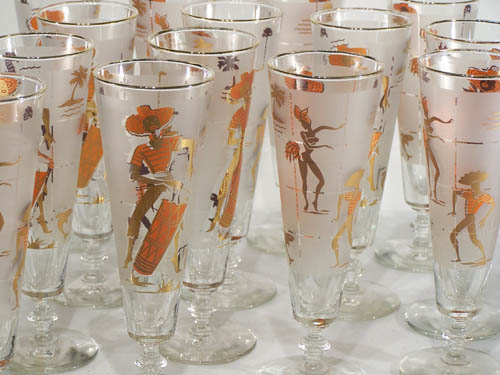
Caribbean Cruise Pilsner Set – Libbey Glass – 1959
These fun glasses from Libbey Glass were introduced in 1959 and only produced through 1961. Unlike the “Golden Foilage” line by Libbey, which was made for most of the 1960’s, this design is much harder to get your hands on and highly sought by fans of Tiki decor. I was lucky enough to come across a set of 14 pilsners and 6 cocktail glasses recently.
Libbey Glass has a long tradition of glass production going back into the 19th Century. The company is still operating as Libbey, Inc. and the company website has the story of their fascinating history.
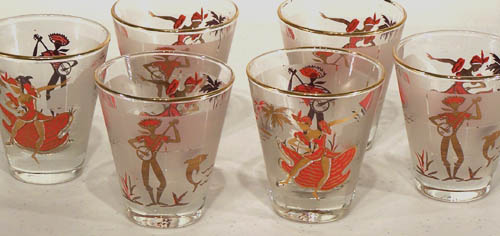
Caribbean Cruise Cocktail Glass Set – Libbey Glass – 1959
This and other Libbey patterns were heavily marketed by owner Owens-Illinios throughout the 1950’s, 60’s and early 70’s in home decor magazines. I ran across this example from a 1959 Better Homes and Gardens.
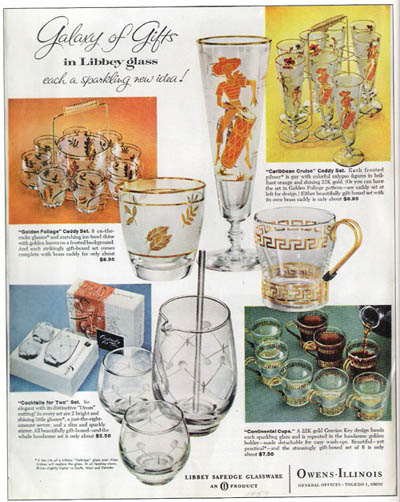
Libbey Glass Advertisement – Better Homes and Gardens – 1959
Caribbean Cruise is one of the most playful and entertaining of Libbey’s mid-century designs and, although harder-to-find then some other patterns, is well worth seeking out.
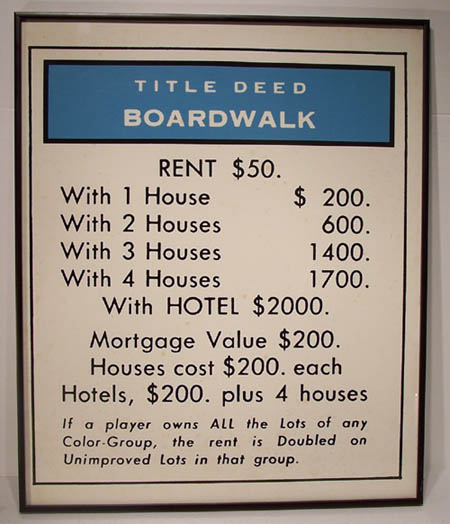
Parker Brothers Monopoly© Boardwalk Deed Poster – Image Masters Inc. – circa 1975
Late in spring photographs on the Design*Sponge blog featured the interior design of West Coast floral studio Wiggy Flowers that included a fabulous Pop Art graphic of a Monopoly© Deed on the wall. A bit nostalgic and also wonderfully modern, this bit of art triggered a discussion on the Apartment Therapy-Chicago blog on where to obtain one of these iconic images.
It seems finding one would be harder than it appears. The one shown in the Design*Sponge post had been created by Wiggy Flowers creative designer Catherine Conlin. Searches online netted little information except for two posters held by a Monopoly© collector.
I had recalled seeing these posts over the weekend while out on my usual hunt at some local estate sales when I came upon a framed Boardwalk Deed poster. Produced by Image Masters Inc. of Van Nuys, CA in the 1970’s this 24-1/4 inch by 20-1/4 inch graphic appears to be screen printed. Further digging seems to indicate this company is no longer in business.
The scarcity of these may be due to Parker Brothers tight licensing of the copyrighted graphics of the game. While the game play of Monopoly© is in public domain, the graphics used by Parker Brothers are not. It appears from markings on the piece I found that this was licensed.
As there had been considerable discussion on this topic in these other blogs I thought I’d share this find here.
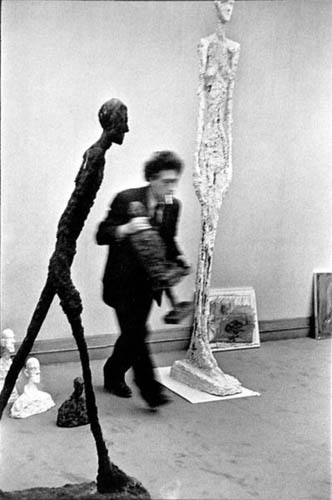
Alberto Giacometti in Studio – Henri Cartier-Bresson – circa 1952
Today marks the 100th Anniversary of the birth of photographer Henri Cartier-Bresson. I first became familiar with the work of Cartier-Bresson through some of his subjects – Picasso, Matisse, Renoir, Calder, Giacometti and Duchamp.
In 1952, Cartier-Bresson authored Images à la sauvette, whose English edition was titled The Decisive Moment. In it, he discussed the philosophy of his art by building on a concept articulated by Cardinal de Retz, “There is nothing in this world that does not have a decisive moment”
In a 1957 Washington Post interview Cartier-Bresson discussed this concept by saying:
“Photography is not like painting. There is a creative fraction of a second when you are taking a picture. Your eye must see a composition or an expression that life itself offers you, and you must know with intuition when to click the camera. That is the moment the photographer is creative. Oop! The Moment! Once you miss it, it is gone forever.”
Oop! The Moment! Once you miss it, it is gone forever.
Words as true in life as they are in art as we each face our own “decisive moments.”
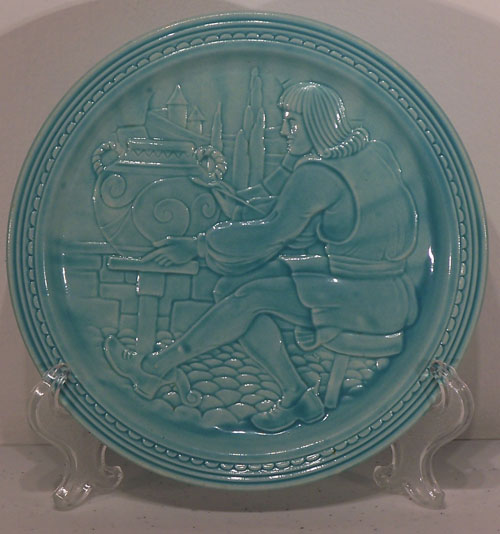
The Potter’s Wheel – Homer Laughlin Co. – 1939 World’s Fair
With the upcoming Fiesta Tent Sale this weekend in Flatwoods, WV it seemed a good time to focus on my favorite piece of Homer Laughlin China. While a fan of Fiesta, (the modern lady and I have a relatively large collection of early pieces in red, cobalt, yellow and light green with a few pieces of the 1950’s chartreuse) I don’t collect any of the current color line.
The highlight of my Homer Laughlin collection is a commemorative plate made during the 1939 World’s Fair at The Joint Exhibit of Capital and Labor. HLC and several other pottery companies built a demonstration kiln for the exhibit and produced these great plates. The National Brotherhood of Operative Potters Union manned the exhibit. Glazed in the Fiesta light blue, this plate features a medieval potter at the potter’s wheel. All pieces were marked on the back as shown here:
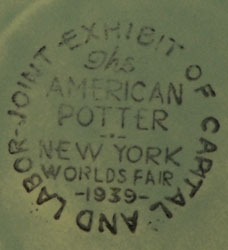
The history of items intrigues me as much as the item itself sometimes and this is certainly the case with The Potter’s Wheel plate. There were a few other designs of plates made, all around the same theme, but this is the only one I currently have. As I find others I’ll share them here.
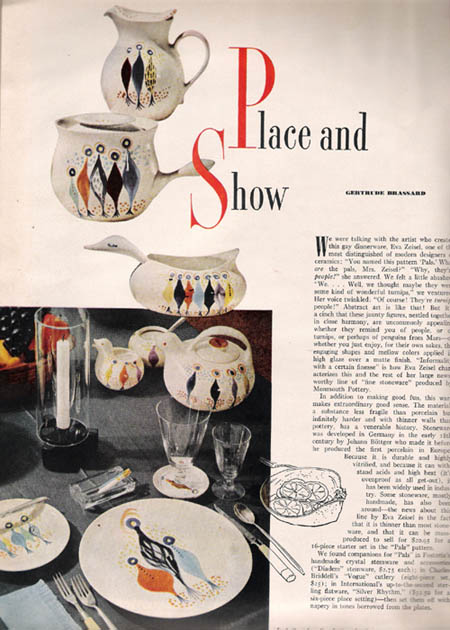
Place and Show – The American Home Magazine – August 1954
I just acquired a large stash of 1950’s The American Home magazines and have been like a kid in a candy shop. We are always on the lookout for interior design magazines from this period, as they are the best reference materials available on many mid-century items, and this lot has been a virtual treasure trove of information and photographs.
One of the best pieces I ran across the article Place and Show by Gertrude Brassard on Eva Zeisel’s Pals pattern for Monmouth Pottery. I have always been an admirer of Zeisel’s designs and, while having seen this shape before, this was my first opportunity to see the Pals “turnip people” decorations on this dinnerware.
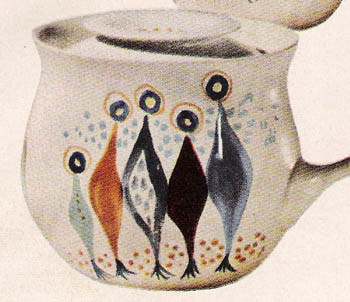
Pals “Turnip-People” detail – Monmouth Pottery – Eva Zeisel – 1954
Starter sets of 16 pieces in this pattern sold for $20.95 in 1954. Prices have, shall we say, increased and finding pieces of Pals, which is very scarce, is a challenge. You can bet I’ll be looking though.
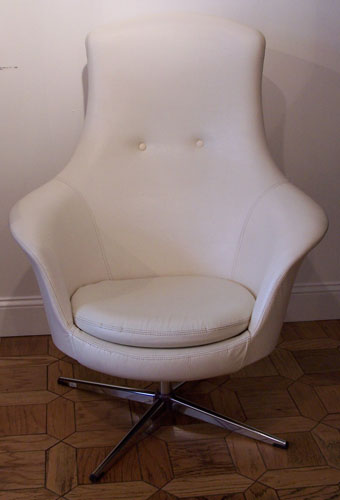
Swivel Chair – Overman USA – Carl Eric Klote – circa 1960’s
In the late 1950’s Swedish designer Carl Eric Klote developed a process of making furniture utilizing a light-weight expandable polystyrene frame for Overman. The company produced pieces in factories in Sweden and Germany before ultimately establishing Overman USA in Knoxville, Tennessee.
Very light, yet so durable the company offered a 25 year guarantee, these pieces have become classics of mid-20th Century design. The chairs and sofas all have sculptural qualities to them and, when properly care for as the one shown here from the early 1960’s has been, are as graceful and fashionable today as the were nearly 50 years ago.
Klote went on to form Klote International Corporation in 1977 which is still producing furniture utilizing the same technique today.
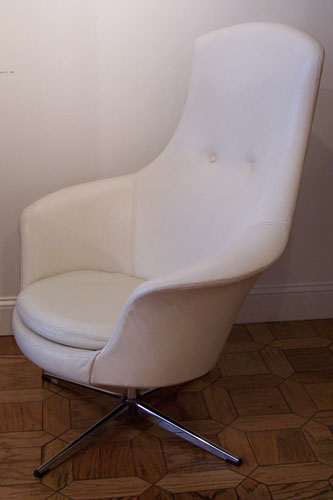
Swivel Chair – Overman USA – Carl Eric Klote – circa 1960’s
Carl Eric Klote passed away in 2007 at his home in Högby, Sweden. He retained his Swedish citizenship until his death while working and keeping a home in the United States. According to Clarence Hamby, the controller of Klote International, he has over 2 million frequent flyer miles when he died.